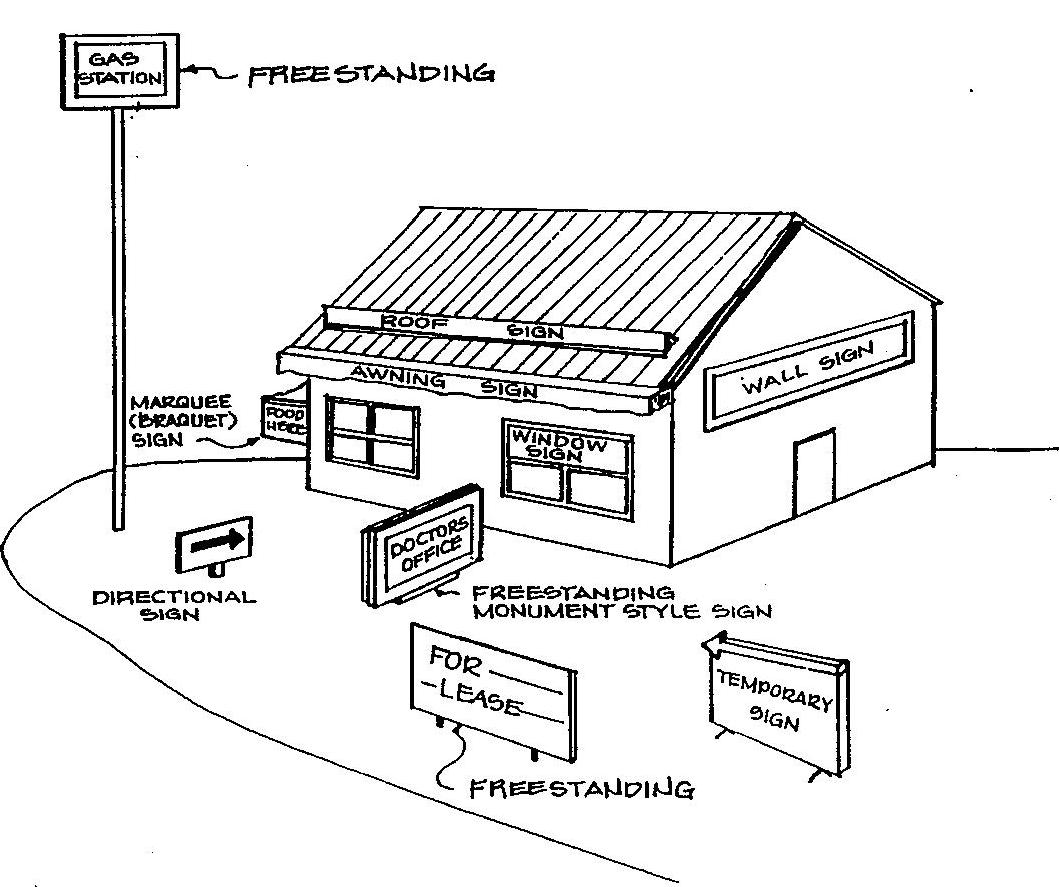For the purpose of this subchapter, the following definitions shall apply unless the context clearly indicates or requires a different meaning.
BUILDING FRONTAGE. The portion of a building which faces a public street right-of-way.
BUSINESS SITE. The property owned by a business proprietor upon which the business is situated or land owned by the management entity of a commercial center or arcade, including any accessory buildings.
CHANGE OF COPY. The replacement of the name of a tenant with another on a sign listing tenants in professional offices or buildings, industrial parks or commercial centers.
MESSAGE UNIT OR ITEM OF INFORMATION. Each of the following equals one MESSAGE UNIT: each word; an abbreviation; a syllable; a number containing up to seven digits; a symbol; a logo; a geometric shape; a person’s or firm’s initials containing up to seven letters. Punctuation marks are not counted in computing a number of MESSAGE UNITS. When a sign has identical messages facing opposite directions, only the MESSAGE UNITS on one side of each such pair shall be counted in computing the permitted number of MESSAGE UNITS. Noncommercial, public signs or message boards whose messages are regularly changed are herein defined as containing only one MESSAGE UNIT.
OUTDOOR ADVERTISING. The public display of graphical information, other than official traffic and information signs, that call public attention to commercial products, businesses or services (both public and private).
SIGN. A name, identification, description, display, light, balloon, banner or illustration which is affixed to, or painted or otherwise located or set upon or in a building, structure or piece of land and which directs attention to an object, product, place, activity, person, institution, organization or business and which, is visible from any public streets, sidewalk, alley, park or public property. The definition includes interior and exterior signs but not signs primarily directed at persons within the premises of the sign owners. The definition does not include goods displayed in a business window. The definition does not include religious symbols or paintings which do not display lettering and do not advertise a business, product or service (see diagram).
(1) FREESTANDING SIGN. A sign which is attached to or part of a completely self-supporting structure. The supporting structure shall be placed on or below the ground surface and not attached to any building or any other structure whether portable or stationary.
(2) MARQUEE (BRACKET) SIGN. A sign attached to a marquee, canopy, or projection extending from and supported by a building. An awning is a MARQUEE SIGN if it has a sign affixed to it.
(3) PORTABLE TEMPORARY SIGN. A single or double surface painted or poster panel type sign or some variation thereof, which is temporary in nature, not mounted on wheels, easily movable, and not permanently attached to the ground.
(4) REAL ESTATE SIGN. A temporary sign placed upon property for the purpose of advertising to the public the sale or lease of said property.
(5) ROOF SIGN. Any sign wholly erected to, constructed or maintained on the roof structure of any building.
(6) WALL SIGN. Any sign that shall be affixed parallel to the wall or painted on the wall of any building; provided, however, said WALL SIGN shall not project above the top of the wall or beyond the end of the building. For the purpose of this chapter, any sign display surface that is affixed flat against the sloping surface of a mansard roof shall be considered a WALL SIGN.
SIGN SURFACE. The part of the sign upon, against or through which the message is displayed or illustrated.
TOTAL SURFACE AREA OF THE SIGN.
(1) The sum total of all exterior surfaces of the sign, computed in square feet. In the case of a broken sign (a sign with open spaces between the letters, figures, numbers or symbols), the
TOTAL SURFACE AREA shall be measured by multiplying the height of the individual letters or combination of letters by the distance between the outer edges of the two furthermost letters.
(2) If an internally-lighted awning is translucent or transparent, the entire awning area shall be included in the calculations of the
TOTAL SIGN SURFACE AREA (see diagram).

(Ord. 1, passed 11-13-2000, § 4.2)